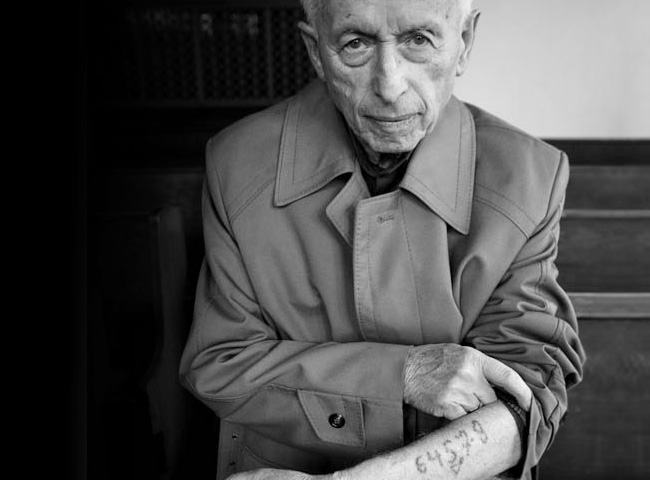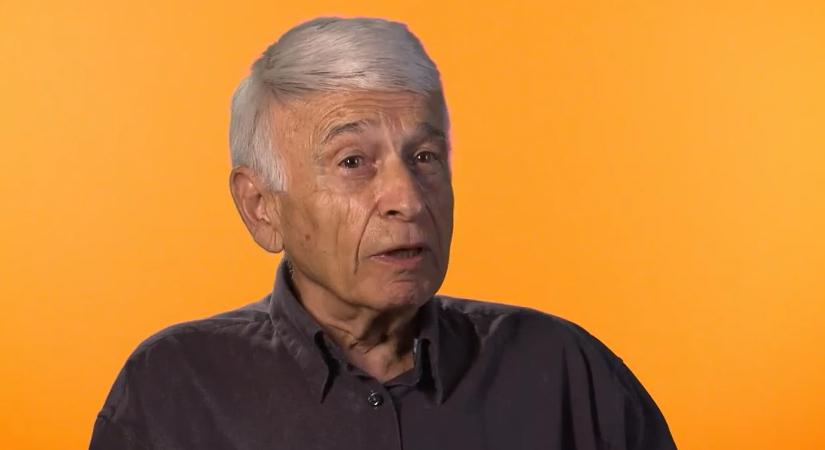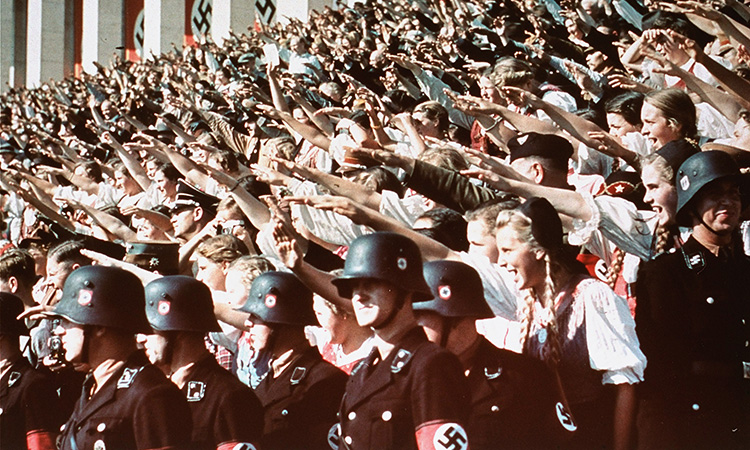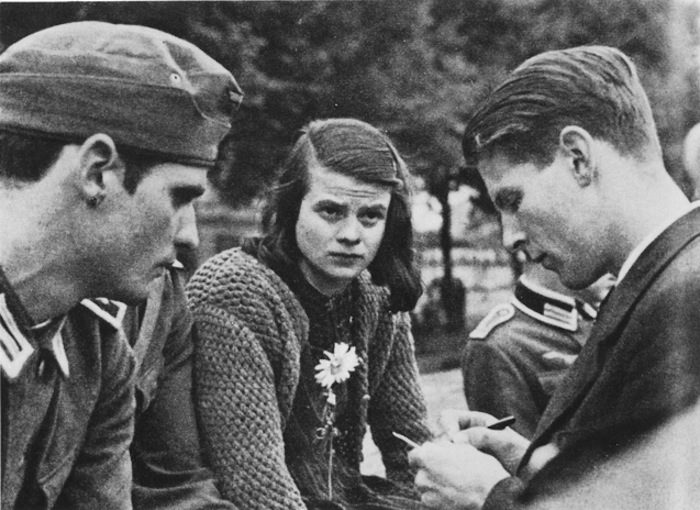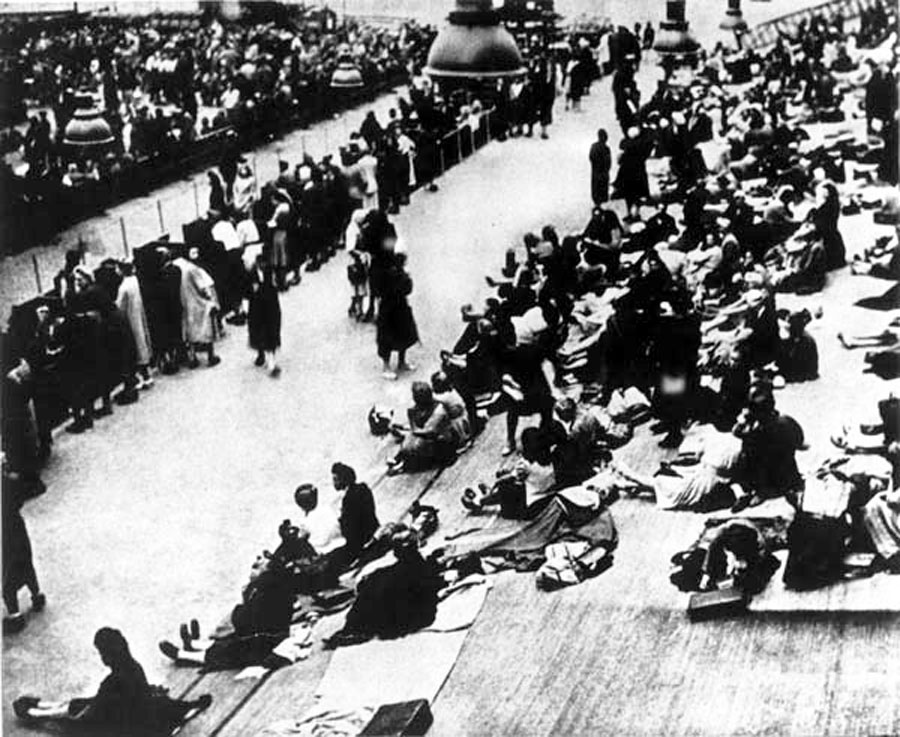Educator Tools

 Ask yourself:
Ask yourself:
- What do you know about the Holocaust?
- What could have motivated people to vote for Adolf Hitler and to accept his antisemitic policies?
- Was there a clear divide between his supporters and those who dissented?
- What about people who didn’t care either way–how does the role of a bystander fit into the discussion?
This chapter examines the systematic mass murder of European Jewry by Nazi Germany and their collaborators, known as the Holocaust. The horror of this historical crime is revealed in the testimonies of the survivors. Below you will find a timeline of the events leading up to the Holocaust, and a summary of the Jewish population in the countries involved in the Holocaust.
When studying genocide, we might ask ourselves how the world can let such horrendous events occur. This chapter will allow you to examine this question in more detail by using the Holocaust as a case study for discussing the roles played by conformists, dissenters, and bystanders. You will examine primary sources from multiple perspectives to understand why historical characters thought and acted as they did, as well as learning the importance of avoiding generalizations. Afterwards, you will reflect on the role of a bystander and decide where this role fits within the discussion and within your own lives.
Basic Facts
The Second World War (1939-1945) was not only characterized by territorial conquest, but also by the strong ideological and racist elements mobilizing that conquest. The racial ideology was founded on pseudo-scientific racial theories and antisemitism driven by Adolf Hitler and Germany’s National Socialist Party. Hitler was essentially a racial imperialist and he invaded all his neighbours to gain economic advantage and living space (Lebensraum) in the East for the expanding German people who were believed to be superior to everyone else. Beginning in 1933, when Adolf Hitler became Chancellor, he made antisemitism state policy and worked to remove the Jewish minority from German social and economic life. These same policies were extended to every land he occupied and later during the war (1941) he made the decision to murder all Jews throughout Europe.
During the Second World War, countless physical acts of violence were perpetrated against Jews and other groups deemed “undesirable” by the Nazis. Across Europe, Jewish people were shot to death, starved, poisoned in gas chambers, and burned in ovens. Prior to the war, there were approximately 11 million European Jews and by the war’s end approximately 6 million were killed.
When learning about the Holocaust we might ask ourselves how the world let such a horrendous event occur. The truth is the extent of the genocide was not widely known until years after the war when historians started to study the Hitler regime. In this chapter we will be examining the historical perspectives of different actors associated with the Holocaust and the roles they played as well as their attitudes towards the event.
Historical Perspectives
Taking the time to consider multiple historical perspectives helps inform our understanding of the past and provides us with insight into why certain events occurred as they did. It goes beyond identifying and empathizing with historical actors, to investigating the historical context that influenced the thoughts and actions of people at that time. However, we have to be careful not to make assumptions about the past using our own sets of values and beliefs, because our standards differ from those in other times and places in history. This being said, we can use historical evidence as an entry point to understanding the various political, social, economic, geographic, and emotional contexts that shaped the past and people’s perspectives. You will have the opportunity to use the primary sources (artifacts) below to understand a variety of historical perspectives.
 Ask yourself:
Ask yourself:
- Why are personal stories so valuable when we study history?
- What do we learn from listening to survivors of the Holocaust?
History of the Holocaust – Timeline
| Year | Events in History |
|---|---|
| 1933 |
|
| 1934 |
|
| 1935 |
|
|
1936 |
|
| 1938 |
|
| 1939 |
|
| 1940 |
|
| 1941 |
|
| 1942 |
|
| 1943 |
|
| 1944 |
|
| 1945 |
|
ACTION 1
Do
Living Graph Template
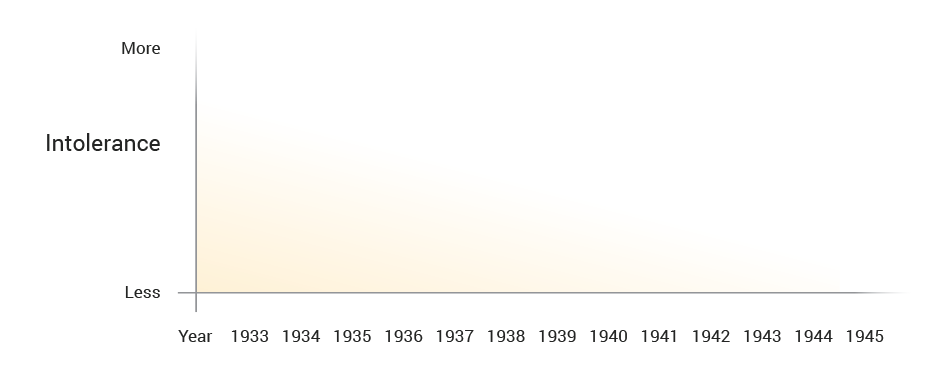
Look at the events of each year in the timeline. Place a dot on the above graph to represent the level of intolerance displayed. Link the dots to form a line graph.
Wannsee Protocol
This is a list of the countries where Jews were living in Europe and therefore targeted by the Nazis during the Wannsee Conference on January 20, 1942. The meeting was called to organize and implement the Nazi “Final Solution to the Jewish Question.” This is the list included in the official minutes of the meeting, known as the Wannsee Protocol.
JEWISH PEOPLE
| Country—Listed | Population |
|---|---|
| Altreich (Germany pre-1938) | 131,800 |
| Ostmark (Austria) | 43,700 |
| Eastern territories (incorporated from Poland) | 420,000 |
| General Government (also in Poland) | 2,284,000 |
| Bialystok (White Russia) | 400,000 |
| Protectorate of Bohemia and Moravia | 74,200 |
| Estonia—Free of Jews | — |
| Latvia | 3,500 |
| Lithuania | 34,000 |
| Belgium | 43,000 |
| Denmark | 5,600 |
| France: occupied territory | 165,000 |
| unoccupied territory | 700,000 |
| Greece | 69,600 |
| The Netherlands | 160,000 |
| Norway | 1,300 |
| Bulgaria | 48,000 |
| England | 330,000 |
| Finland | 2,300 |
| Ireland | 4,000 |
| Italy including Sardinia | 58,000 |
| Albania | 200 |
| Croatia | 40,000 |
| Portugal | 3,000 |
| Romania including Bessarabia | 342,000 |
| Sweden | 8,000 |
| Switzerland | 18,000 |
| Serbia | 10,000 |
| Slovakia | 88,000 |
| Spain | 6,000 |
| Turkey (European part) | 55,500 |
| Hungary | 742,800 |
| USSR | 5,000,000 |
| Ukraine | 2,994,684 |
| White Russia excluding Bialystok | 446,484 |
| Total | Over 11,000,000 |
 Artifacts
Artifacts
Artifact 1 › Photograph of Hitler’s youth organizations, 1938 (separate organizations for boys and girls)
Nazi youth, 1938
Artifact 2 › Passages from a popular children’s book used in German Schools, 1936
“The Lord God conceived the races:
Red Indians, Negroes, and Chinese,
And Jew, too, the rotten crew . . .
He gave them all a piece of earth
To work with the sweat of their brow.
But the Jew went on strike at once!
For the devil rode him from the first.
Cheating, not working, was his aim;
For lying, he got first prize”
“The Jew has always hated him!
Here is the Jew, as all can see,
Biggest ruffian in our country;
He thinks himself the greatest beau
And yet is the ugliest, you know!”
Source: Bauer, Elvira. Trust No Fox on his Green Heath and No Jew on His Oath. Nuremberg: Sturmer Verlag, 1936.
Permission granted by Randall Bytwerk
Artifact 3 › Memoirs of two German soldiers from the Reserve Police Battalion 101, a death squad ordered to kill the Jews of Jozefow, Poland during the summer of 1942.
“Those who did not want to or could not carry out the shooting of human beings with their own hands . . . remained by the arriving trucks and kept himself busy at arrival point. It could not be avoided that one or another of my comrades noticed that I was not going to the execution . . . they showered me with remarks such as ‘shithead’ and ‘weakling’ to express their disgust. I was not the only one who kept himself out of participating.”
“I then cocked my carbine and shot him [an elderly Jew] through the back of the head. Because I was already very upset from the cruel treatment of the Jews . . . parts of the skull flew . . . I had become so sick that I simply couldn’t anymore.”
Source: Christopher Browning, “Ordinary Men” in The Holocaust: Problems and Perspectives of Interpretations, edited by Donald L. Niewyk (Connecticut, Wadsworth Publishing, 2011), 76-90.
Artifact 4 › Photograph of three members of the White Rose Movement in Munich, Germany
The White Rose Movement
The White Rose was a youth movement active in Munich, Germany from June 1942 to February 1943. It was founded by Hans Scholl and his friends in medical school.
Artifact 5 › Passages from two of the leaflets that the White Rose anonymously distributed throughout Munich and surrounding German cities.
“It is certain that today every honest German is ashamed of his government. Who among us has any conception of the dimensions of shame that will befall us and our children when one day the veil has fallen from our eyes and the most horrible of crimes—crimes that infinitely outdistance every human measure—reach the light of day?”
First Leaflet, 1942
“Since the conquest of Poland three hundred thousand Jews have been murdered in this country in the most bestial way. Here we see the most frightful crime against human dignity, a crime that is unparalleled in the whole of history. For Jews, too, are human beings—no matter what position we take with respect to the Jewish question—and a crime of this dimension has been perpetrated against human beings.“
Second Leaflet, 1942
Source: Inge Scholl, The White Rose: Munich 1942-1943, Trans. Arthur R. Schultz (Connecticut: Wesleyan University Press, 1983), 73-80.
Artifact 6 › A response from the United States Federal Government concerning the approaching S.S. St. Louis (Telegram sent June, 1939)
Those aboard the S.S. St. Louis must, “await their turns on the waiting list and qualify for and obtain immigration visas before they may be admissible into the United States.”
Artifact 7 › A photograph taken at the Vel’ d’Hiv Roundup in Paris, July 1942.
Over the two days of July 16 and 17 in 1942, 13,000 Jews (including 4,000 children) were rounded up by French police (not Germans) in Paris and contained in the bicycle stadium called Vel’ d’Hiv (Vélodrome d’Hiver), where they were held for five days before being transported to transit camps in France and on to death camps in the East. Most of them were killed in Auschwitz.
Artifact 8 › Quotes from residents living in Le Chambon-Sur-Lignon, a village in south central France.
From December 1940 to September 1944, the inhabitants of the small French village of Le Chambon-sur-Lignon, led by Pastor André Trocmé of the Reformed Church of France, his wife Magda, and his assistant, Pastor Edouard Theis, and the villages on the surrounding plateau, provided refuge for an estimated 5,000 people. This number included about 3,000–3,500 Jews who were fleeing from the Vichy authorities and the Germans.
“As soon as the soldiers left, we would go into the forest and sing a song. When they heard that song, the Jews knew it was safe to come home.” (1941)
“We didn’t protect the Jews because we were moral or heroic people. We helped them because it was the human thing to do.” (1989)
ACTION 2
Think
Mind-Webs
Historically, why do you think people living under Hitler conformed with or dissented from actions taken against the Jewish minority? Create a mapping of connected thoughts and decisions made demonstrating these linkages.
ACTION 3
Think
My connections to history
Take a moment to independently and carefully observe each of the artifacts from 1 to 5. What intrigued you about these artifacts? How are they important to our knowledge of the Holocaust?
ACTION 4
Discuss
Seeing the stories
Complete the following exercises with a partner:
- Compare Hitler’s Youth organizations and the White Rose Movement (artifacts 1 & 4). What are some similarities and differences between these organizations?
- Re-examine artifact 2: how effective is a children’s book as a tool for propaganda? Typically, propaganda is used to target older age groups. Why would targeting children be significant?
- Does artifact 5 provide us with an accurate representation of Nazi German soldiers or is this a special case? How useful are these quotations in helping us understand the perspectives of German soldiers?
- Evaluate whether each artifact provides us with an example of a person or group conforming to, or dissenting from, the persecution of Jews during the Holocaust. Explain your reasoning.
ACTION 5
Discuss
Using artifacts 6 through 8, discuss the following questions with a partner.
- What are some of the possible risks people faced when conforming to, or dissenting from, Nazi policy?
- To what extent do you think that societal systems and structures influenced the actions of people?
- Explain whether or not artifact 6 is an example of conforming to the Nazi regime? How do the actions of the French police in artifact 7 compare?
- To what degree was the United States justified in delaying Jewish refugees entry? Is it fair to allow unlimited entry to any refugee? Where and when should we draw the line?
ACTION 6
Think
The Bystander
Martin Niemöller (1892–1984) was a prominent Lutheran pastor in Germany. In the 1920s and early 1930s, he sympathized with many Nazi ideas and supported right-wing political movements. But after Adolf Hitler came to power in 1933, Niemöller became an outspoken critic of Hitler’s interference in the affairs of the Lutheran Church. He spent the last eight years of Nazi rule, from 1937 to 1945, in Nazi prisons and concentration camps.
Read the following poem written by Martin Niemöller.
First they Came
First they came for the Socialists,
and I did not speak out—Because I was not a Socialist.
Then they came for the Trade Unionists,
and I did not speak out—Because I was not a Trade Unionist.
Then they came for the Jews,
and I did not speak out—Because I was not a Jew.
Then they came for me—and there was no one left to speak for me.
Source: The United States Holocaust Memorial Museum.
Reflections
- Independently, reflect on how this poem speaks to us about the role of a bystander.
- In your opinion, where does a bystander fit into our discussion of conformists and dissenters? Discuss with a partner whether a bystander should be considered the former or the latter.
ACTION 7
Think
Nazi Medical Experiments
During the Second World War, a number of Nazi German physicians conducted painful and often deadly experiments on thousands of prisoners in concentration and death camps.
Read about Nazi Medical Experiments
The best known doctor to experiment on inmates, especially twins, was SS doctor Josef Mengele, who was also in charge of the selection process at the largest death camp in Poland, Auschwitz. He had the power to decide who would become a forced labourer and who would be gassed and burned on arrival. Known as the Angel of Death, he escaped to South America after the war and died in Brazil in 1979 having escaped justice.
Read about Josef Mengele
Among the inmates Mengele experimented upon were twins. Approximately 1500 sets of twins were abused by Mengele, including Eva and Miriam Mozes.
Read about Eva Mozes Kor
ACTION 8
Do
Prosecution of Nazi War Criminals
Some people feel that Nazi war criminals should have been deported and prosecuted for their crimes, regardless of their age and health, or how many years they lived in Canada. Do you agree?
Read about Simon Wiesenthal, who was a Holocaust survivor and dedicated his life to hunting down the perpetrators of the Holocaust to bring them to justice.
ACTION 9
Do
What kind of world do you want to create?
- Use words, phrases and graphics clipped from magazines to create a collage depicting the kind of country you think Canada is and should be in the future. Write a paragraph to explain to what extent you think we have achieved this and what areas we still need to work on.
- Whose responsibility is it to inculcate the values of a just and a moral society: school; home; place of worship; some combination of these? Write a paragraph explaining your thoughts.
Further Reading
Elie Wiesel, Night
Primo Levi, Survival in Auschwitz (If This Is A Man)
Anne Frank, Diary of Anne Frank
Christopher Browning, The Origins of the Final Solution (2003)
Raul Hilberg, Destruction of the European Jews (1985)
Saul Friedländer, Nazi Germany and the Jews, volumes 1 & 2
Films
In Darkness (2011)
Europa, Europa (1990)
Sophie’s Choice (1982)
Schindler’s List (1993)
Shoah (1985)
Night and Fog (1956)
For Holocaust testimonies, visit the USC Shoah Foundation YouTube page.
Every effort has been made to gain permission from copyright holders to reproduce borrowed material. The publishers apologize for any errors and will be pleased to rectify them in subsequent reprints and website programming
Educator Tools



